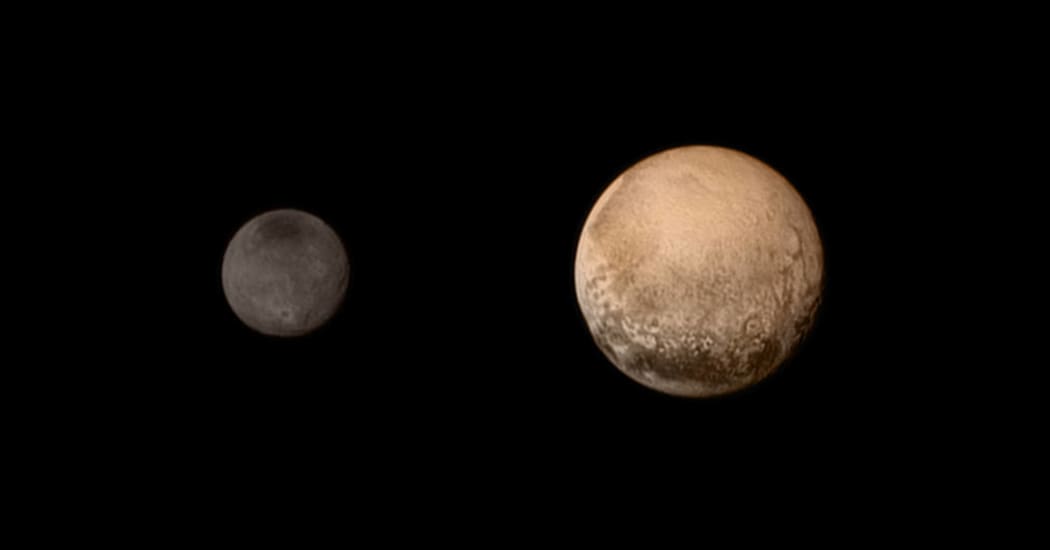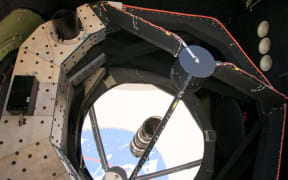A signal received from the New Horizons spacecraft shows that it survived its historic encounter with Pluto.

The last image sent from New Horizons before it passed close to the planet is dominated by the large, bright feature informally named the 'heart'. Measuring some 1600km across, much of the heart's interior appears featureless, which Nasa says may be a sign of ongoing geologic processes. Photo: NASA/APL/SwRI
Data in its first call home since today's flyby suggest the spacecraft experienced no upsets as it hurtled past the icy world at 14km per second.
The signal came through a giant dish in Madrid, Spain - part of a Nasa network of communications antennas.
Received at 01:53 BST, the message took four hours and 25 minutes to traverse 4.7 billion km of space.
There was joy and relief at mission headquarters in Laurel, Maryland as scientists and engineers cheered, hugged each other and waved American flags.
"We are in lock with telemetry from the spacecraft," said mission operations manager Alice Bowman as confirmation was received.
"We have a healthy spacecraft, we have recorded data from the Pluto system, and we are outbound from the Pluto system."
A few minutes later, she added: "I can't express how I feel. It's just like we planned it!"
The event culminated an initiative to explore the solar system that the space agency embarked upon more than 50 years ago.
The spacecraft is so far away that radio signals, travelling at the speed of light, take about four and a half hours to reach Earth.
When New Horizons was launched in 2006 Pluto was still considered the solar system's ninth planet but was shortly after demoted to the status of "dwarf planet".
It was expected to continue observing Pluto for several hours after it made its closest approach to the unexplored world, coming within 12,472km of the sphere.
The diminutive spacecraft, which is about the size of a piano, is not equipped with the propellant needed to brake and slip into orbit around Pluto. Like Nasa's Voyagers and sister predecessor exploratory spacecraft, New Horizons was designed to conduct its survey on the fly.
Managers estimated there was a 1-in-10,000 chance that a debris strike could destroy New Horizons as it traverses the Pluto system.
With 99 percent of the data gathered about Pluto still on the spaceship, its survival was critical to the mission.

Pluto and Charon display striking color and brightness contrast in this composite image from 11 July. Photo: NASA
Already, the trickle of images and measurements coming from New Horizons has changed scientists' understanding of Pluto.
Once considered an icy, dead world, the planetoid has yielded signs of geological activity, with evidence of past and possibly present-day tectonics, or movements of its crust.
Pluto circles the sun every 248 years in a highly tilted orbit that creates radical changes from season to season.
Pluto travels closer to the sun than the orbit of Neptune before it cycles back into the solar system's deep freeze more than 40 times farther away than Earth.
Scientists have many questions about Pluto, which was still considered the solar system's ninth planet when New Horizons was launched in 2006.
Pluto was reclassified as a "dwarf planet" after the discovery of other Pluto-like spheres orbiting in the Kuiper Belt, the region beyond the eighth planet, Neptune.
The objects are believed to be remnants from the formation of the solar system 4.6 billion years ago.
It will take about 16 months for New Horizons to transmit back all the images and measurements taken during its pass by Pluto.
By then, the spacecraft will have travelled even deeper into the Kuiper Belt, heading for a possible follow-on mission to one of Pluto's cousins.
- Reuters/ BBC





